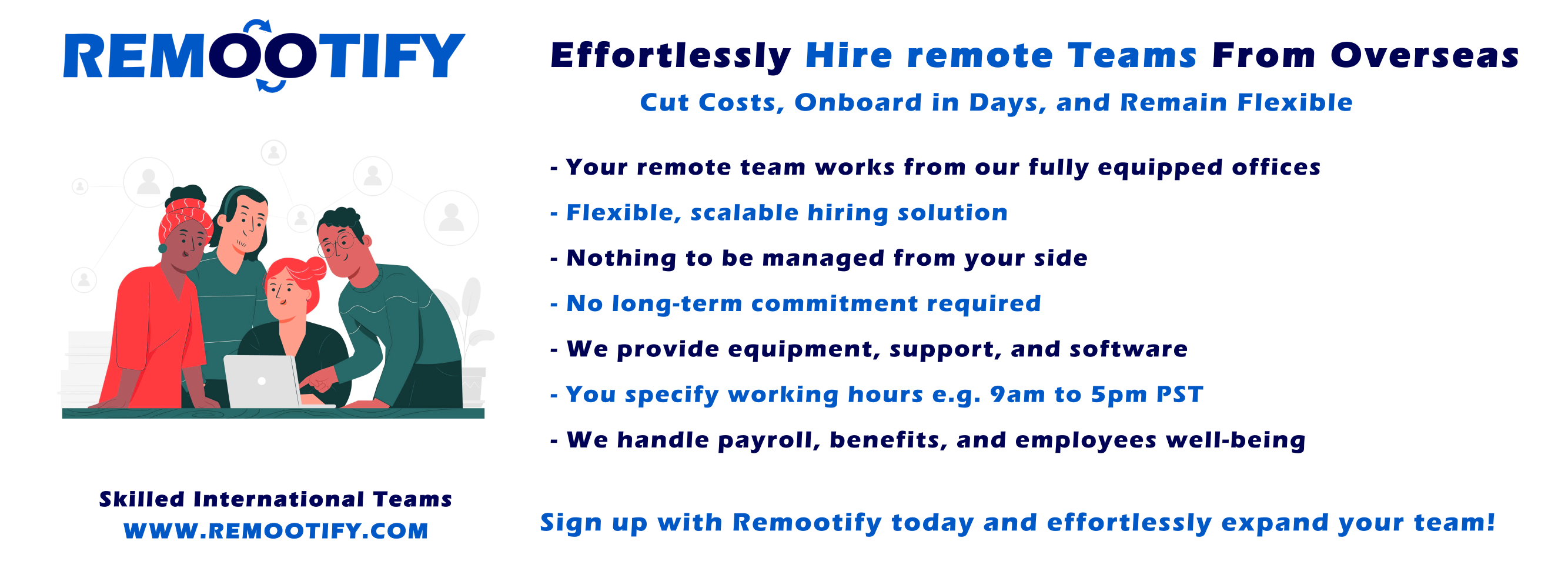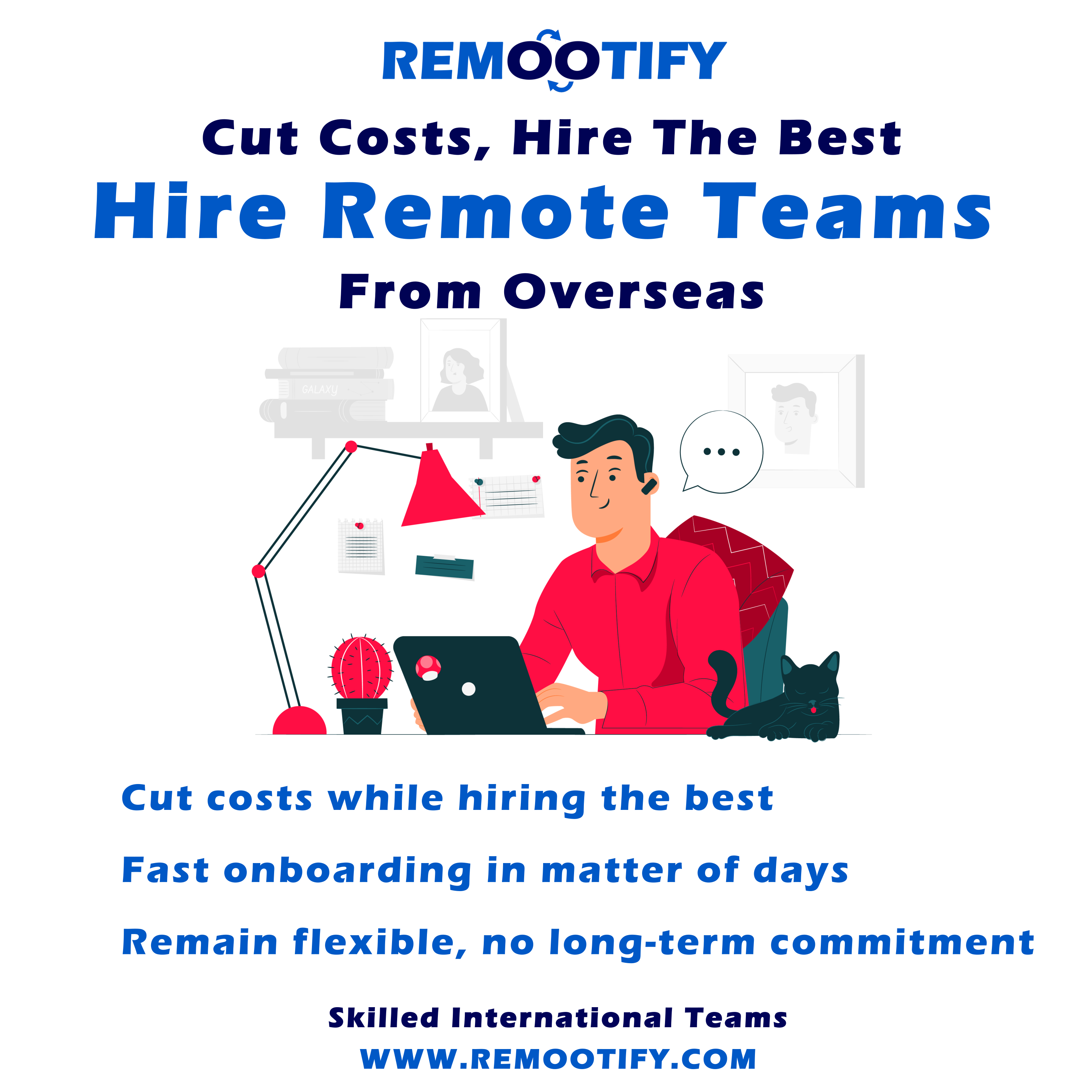Start hiring YOUR REMOTE TEAM, Today!
Enter your information below to start a discussion with one of our team members!

As the traditional boundaries of work dissolve, startups are presented with both new challenges and opportunities.
How can startups effectively embrace remote hiring to construct robust virtual teams?
This article presents seven invaluable remote hiring tips, equipping startups with the insights needed to navigate this evolving landscape.
So, let’s embark on this journey towards building strong virtual teams.
Key Preparations and Considerations for Implementing Remote Work
- Infrastructure Readiness:
- Ensure reliable internet and necessary hardware.
- Communication Strategy:
- Establish clear communication guidelines.
- Remote Work Policies:
- Develop comprehensive remote work policies.
- Technology Stack:
- Choose suitable tools for communication and collaboration.
- Performance Metrics:
- Define productivity metrics based on outcomes.
- Onboarding Process:
- Create remote-friendly onboarding procedures.
- Security Measures:
- Implement strong cybersecurity protocols.
- Team Training:
- Provide remote work and security training.
- Cultural Reinforcement:
- Maintain company culture through virtual events.
- Conflict Resolution:
- Set protocols for addressing conflicts remotely.
- Legal Considerations:
- Understand remote work legal implications.
- Inclusivity and Diversity:
- Design inclusive remote policies.
- Documentation Practices:
- Emphasize documenting processes and decisions.
- Feedback Mechanisms:
- Set up regular feedback channels.
- Wellness Initiatives:
- Prioritize employee well-being.
- Emergency Preparedness:
- Develop remote-specific contingency plans.
- Change Management:
- Anticipate and manage resistance to change.
- Data Privacy:
- Educate employees about data privacy.
- Legal Documentation:
- Update contracts for remote arrangements.
- Adaptability:
- Be open to adjusting remote strategies.
- Trial Period:
- Consider starting with a remote work trial.
Embracing Remote Hiring Tips for Startup Growth and Global Impact
- Access to Global Talent: Implementing effective remote hiring tips enables startups to tap into a diverse pool of skilled candidates from around the world.
- Cost-Efficiency: By following remote hiring tips, startups can save on office space, equipment, and other overhead costs.
- Flexible Workforce: Applying remote hiring tips allows startups to build a flexible team that can adapt to changing project needs and time zones.
- Wider Candidate Selection: With remote hiring tips, startups can select from a broader range of candidates, finding the best fit for their roles.
- Enhanced Productivity: Proper implementation of remote hiring tips can lead to increased productivity and performance among remote teams.
- Innovative Collaboration: Following remote hiring tips encourages startups to adopt innovative tools and practices for seamless virtual collaboration.
- Scalability: Remote hiring tips enable startups to scale their teams quickly without being limited by geographical constraints.
- Cultural Diversity: By following remote hiring tips, startups can foster a team with diverse cultural perspectives, enriching creativity and problem-solving.
Top 7 Remote Hiring Tips
1. Define Clear Job Descriptions
This is among the most important remote hiring tips. Start with detailed and accurate job descriptions. Clearly outline the roles, responsibilities, skills required, and expectations for the remote position. This helps candidates understand the role better and ensures a good fit.
Crafting an Effective Job Description
Understand the Role
- Clearly define the job’s purpose, responsibilities, and scope.
- Identify the key qualifications, skills, and experience required.
Title and Summary
- Choose a concise, relevant job title that accurately reflects the role.
- Write a brief summary that highlights the main aspects of the job.
Job Responsibilities
- List the primary tasks and duties the employee will be responsible for.
- Use action verbs to describe responsibilities and focus on essential functions.
Qualifications and Requirements
- Outline the necessary qualifications, such as education, certifications, and experience.
- Differentiate between “required” and “preferred” qualifications.
Skills and Competencies
- Specify the technical, soft, and interpersonal skills needed for the role.
- Highlight skills that are crucial for success in the position.
Company Culture and Values
- Mention how the role aligns with the company’s mission and values.
- Describe the work environment and any unique aspects of the company culture.
Reporting Structure
- Clarify who the employee will report to and any positions they will supervise.
- Explain how the role fits within the larger organizational structure.
Benefits and Perks
- Provide information about compensation, benefits, and any incentives.
- Mention perks, such as flexible work arrangements or professional development opportunities.
Location and Schedule
- Specify that the job is remote.
- Outline the expected work hours, including any flexibility or shifts.
Application Process
- Describe the application method (e.g., online application, email submission).
- Include a closing date for applications, if applicable.
Equal Opportunity and Inclusivity
- Emphasize the company’s commitment to diversity and inclusion.
- Avoid using language that could be perceived as discriminatory.
Formatting and Readability
- Use clear and concise language, avoiding jargon and complex terms.
- Use bullet points, headings, and subheadings for easy skimming.
Length and Structure
- Keep the job description to a reasonable length (typically 300-700 words).
- Use a logical structure, with organized sections for easy navigation.
Review and Proofreading
- Proofread the job description for spelling, grammar, and formatting errors.
- Have others review the description to ensure clarity and accuracy.
Test for Effectiveness
- Share the job description with colleagues or peers to get feedback.
- Monitor the response rate from candidates to assess the job description’s impact.
Regular Updates
- Periodically review and update job descriptions to reflect evolving roles and needs.
2. Use Video Interviews
Conduct video interviews to assess candidates’ communication skills, body language, and cultural fit, replicating an in-person experience.
How Recruiters Can Identify the Right Fit for the Job
- Preparation
- Review the candidate’s materials and job description.
- Technology Check
- Test video platform and equipment.
- Communication
- Email interview details and technical instructions.
- Professionalism
- Dress professionally and set up a neat, well-lit environment.
- Time Management
- Start on time and allocate time segments.
- Introduction:
- Introduce yourself, and explain the format.
- Icebreaker
- Begin with a brief icebreaker.
- Behavioral Questions
- Ask about experiences using STAR method.
- Technical Assessment
- Conduct technical tests if needed.
- Role and Company Fit
- Discuss role alignment and company contribution.
- Candidate’s Questions
- Allow candidate to ask questions.
- Closing and Next Steps
- Summarize, and explain the next steps.
- Feedback Collection
- Take notes for assessment.
- Candidate Experience
- Address concerns, show empathy.
- Follow-Up
- Send a thank-you email, provide information.
- Evaluation and Decision-Making
- Collaborate, evaluate strengths and weaknesses.
3. Assess Remote Skills
Evaluate candidates’ remote work skills, such as self-motivation, time management, and ability to work independently.
Evaluating Vital Remote Skills
| The aspect of Remote Skills | Assessment Methods |
|---|---|
| Communication | Video interview with scenario-based questions. |
| Time Management | Examples of managing tasks remotely. |
| Problem Solving | Hypothetical remote work challenges. |
| Collaboration | Examples of successful virtual collaboration. |
| Technical Proficiency | Online skills tests or technical discussions. |
| Adaptability | Experience with changing remote environments. |
| Goal Orientation | Setting and achieving goals remotely. |
4. Test Technical Competencies
Administering relevant skills tests or assignments is among the main remote hiring tips. It is done to ensure candidates possess the necessary technical proficiency for the role.
Essential Technical Competencies for Remote Workers
- Digital Proficiency: A strong grasp of digital tools and platforms commonly used for communication, collaboration, and project management.
- Technical Troubleshooting: Ability to diagnose and resolve technical issues independently, minimizing disruptions to work.
- Cybersecurity Awareness: Understanding of cybersecurity best practices to ensure data and communication security while working remotely.
- Cloud and Software Expertise: Familiarity with cloud-based services and software relevant to their role, facilitating remote access and efficient collaboration.
- Virtual Communication Tools: Proficiency with video conferencing, messaging, and other communication tools to effectively engage with team members.
- Time Management Software: Utilizing time tracking and management software to efficiently allocate time, monitor productivity, and meet deadlines.
- Remote Access Skills: Capability to remotely access systems, databases, and resources essential for job responsibilities.
- Adaptability to Remote Tech: Ability to quickly learn and adapt to new remote technologies and tools introduced by the company.
- Data Management Skills: Skill in handling, sharing, and storing data securely while adhering to privacy regulations.
- Coding and Development Skills: If applicable, coding proficiency and software development skills to complete tasks independently.
- Virtual Collaboration Platforms: Experience using tools that facilitate virtual teamwork, such as shared documents, version control systems, and project management platforms.
- Online Learning and Research: Resourcefulness in finding solutions, learning new skills, and troubleshooting through online resources and communities.
- Remote Hardware Management: Competence in managing and troubleshooting personal remote work hardware, such as laptops, webcams, microphones, and peripherals.
- Network Connectivity Awareness: Understanding of networking concepts and troubleshooting connectivity issues to ensure seamless remote work.
- Remote Presentation Skills: Ability to create and deliver effective presentations remotely using appropriate software.
- Version Control Systems: Familiarity with version control systems to collaborate on code or content seamlessly with colleagues.
5. Cultural Fit Assessment
Incorporate questions and scenarios that gauge a candidate’s alignment with your company culture and remote work values.
Cultural Fit Assessment through Targeted Questions
- How would you describe your preferred work environment and team dynamics?
- Can you provide examples of how you’ve collaborated with diverse groups of individuals in previous roles?
- What values do you believe are most important for fostering a positive and inclusive workplace?
- Describe a situation where you had to adapt to a company’s culture that was different from what you were accustomed to. How did you handle it?
- How do you approach resolving conflicts and disagreements with colleagues who have different perspectives or backgrounds?
6. Virtual Onboarding Plan
Develop a comprehensive onboarding plan that provides remote hires with the necessary tools, resources, and guidance to succeed.
7. Utilize Collaboration Tools
Familiarize candidates with the collaboration tools your company uses, such as video conferencing, project management, and communication platforms.
—
Conclusion
In conclusion, as traditional work boundaries dissolve, startups can seize the advantages of remote hiring to foster growth and innovation.
By implementing the outlined remote hiring tips, startups can strategically assemble diverse virtual teams, leveraging global talent, reducing costs, and promoting productivity.
—
FAQs
How can startups benefit from embracing remote work?
Startups can benefit from remote work by accessing a global talent pool, saving on office-related expenses, offering work-life balance, increasing productivity, promoting diverse perspectives, and maintaining business continuity even during disruptions.
What are the remote hiring tips for startups?
To optimize remote hiring, startups should craft clear job descriptions and utilize video interviews for communication assessment.
Evaluating remote skills, testing technical aptitude, and gauging cultural fit is crucial. A structured virtual onboarding plan and familiarity with collaboration tools ensure a seamless transition.
Why are remote hiring tips crucial for startups?
Startups need remote hiring tips to leverage global talent, cut costs, enhance flexibility, boost productivity, and foster diverse teams, ensuring competitiveness and growth in a changing work landscape.





